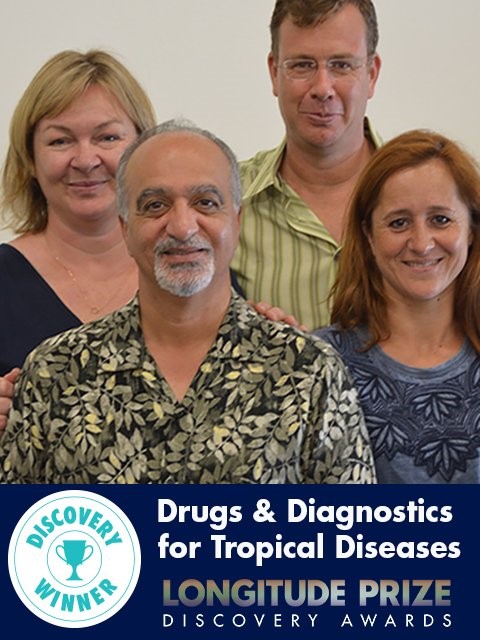This team successfully won a Discovery Award seed-funding grant to help further develop their ideas for their Longitude Prize application and create a diagnostic test that helps solve the problem of global antibiotic resistance. Below we have asked them to explain their test and motivation for applying.
What is your test for?
Microbes are microscopic bugs that infect human beings and rely on a number of proteins for their survival and proliferation. Antibiotics fight these microbes by binding to those proteins and “jamming” them. Some microbes, however, have evolved into mutants and have become resistant to certain antibiotics. They feature mutated proteins, which the antibiotics can no longer bind to.
Our team is developing a test to determine if an antibiotic can still bind to its targeted protein or not. It will give an answer within minutes without any specialised equipment and will enable a medical doctor to test a patient in his/her office, and prescribe an antibiotic that will work.
Please share a more detailed description of this work from a medical professional’s perspective.
The standard methodology to determine which antibiotic should be prescribed for a given infection is to perform a susceptibility test.
The microbe is cultured on a plate in the presence of an array of potential antibiotics. Only the antibiotics that completely inhibit microbial growth can be recommended as treatment.
Susceptibility tests require a minimum of one day to perform, and do not allow a medical doctor to make a decision on the spot. We propose a rapid antimicrobial resistance test. The assay determines if, for a given pathogen, an antibiotic can bind to its intended biological target or if the latter has mutated into a drug-resistant form. Because binding events are so fast, the test will be complete within minutes, allowing a decision to be made at the point-of-care. The assay obviates the need for cell culture and is based on a lateral flow assay (LFA) format, the same format as the consumer pregnancy test.
Why did you apply and what will the Discovery Award funding be used for in your work?
The proposed methodology is ambitious, but the data garnered using our Discovery Award will provide the confidence necessary to invest additional resources in our test. The funding will be used to generate a prototype focusing on the antibiotic ciprofloxacin.
What difference will your work make in the long term with regards to antimicrobial diagnostics?
In the long term, we hope to extend our device to simultaneously analyse potential resistance to all antibiotics that are designated as essential medicines by the WHO. We further hope to create an algorithm for the management of pediatric diarrhoea, which remains a major killer worldwide.
If there is a design for a prototype, please describe it and how it will work.
The format is a lateral flow assay (LFA), where:
(1) The antibiotic is immobilised as a test line on a nitrocellulose strip.
(2) A microbe lysate is passed on the nitrocellulose. The biological target will bind to the test line, but only if it is drug-susceptible and is devoid of drug-resistant mutations.
(3) Brightly colored reporter nanoparticles conjugated to an anti-target antibody are run onto the nitrocellulose. They will bind to the target-test line complex, giving rise to a visual signal.
Specifically, the prototype will be configured to determine if the antibiotic ciprofloxacin can bind its target, DNA-gyrase, in an E. coli lysate. Furthermore, we will employ high-contrast gold nanoparticles recently co-developed with nanoComposix, San Diego.
Who is on your team?
Dr. Marco A. Biamonte (Founder, CEO)
Dr. Valerie Pasquetto (VP of Operations)
Dr. Maria J. Gonzalez-Moa (Sr. Scientist)
Mr. Bijan Pedram (Sr. Scientist).

